A Study of Knowledge, Attitude, and Practice about Thalassemia among the People of Gilgit and Azad Kashmir, Pakistan
DOI:
https://doi.org/10.55737/qjssh.040110122Keywords:
Thalassemia, Gilgat, Azad Kashmir, Anemia, Pakistan, Blood Born Disease, Family MarriagesAbstract
Thalassemia, an inherited blood ailment with a 5 to 8% frequency in the beta-thalassemia gene, is a significant health issue in Pakistan, regardless of ethnicity. A study was conducted in Gilgat, Azad Jammu Kashmir, Pakistan, to assess the general public's awareness of the disease. A systematic questionnaire was created, asking 24 questions on awareness. Only 178 participants answered the questionnaire, indicating low knowledge. Those who correctly answered 13-18 questions had average knowledge, while those who answered more than 18 questions had strong knowledge. Of the 178 participants who had heard the term, 5.4% had a "good" level of awareness, 20.6% had average understanding, and 74% had poor understanding. The study revealed that the general population of Gilgit and Azad Jammu Kashmir, Pakistan, had little understanding of Thalassemia.
References
Ahmed, D., Zafar, H., Bukhari, K. T., Nawaz, M. N., & Ammar, M. (2017). Identification of common ways for thalassemia awareness in medical and non-medical professionals. Pharmaceutical and Biosciences Journal, 01-05. https://doi.org/10.20510/ukjpb/5/i5/166548
Ahmed, S., Jafri, H., Rashid, Y., Ehsan, Y., Bashir, S., & Ahmed, M. (2021). Cascade screening for beta-thalassemia in Pakistan: Development, feasibility and acceptability of a decision support intervention for relatives. European Journal of Human Genetics, 30(1), 73-80. https://doi.org/10.1038/s41431-021-00918-6
Akhtar, S., Nasir, J. A., & Hinde, A. (2020). The prevalence of hepatitis C virus infection in β-thalassemia patients in Pakistan: A systematic review and meta-analysis. BMC Public Health, 20(1), 1-9. https://doi.org/10.1186/s12889-020-8414-5
Ansari, S. H., Parveen, S., Siddiqui, S., Perveen, K., Ahmed, G., Kaleem, B., Ahmed, S., Zohaib, M., Farzana, T., & Shamsi, T. (2018). Managing thalassemia in the developing world: An evidence-based approach for prevention, transfusion Independency, and curative treatment with hematopoietic stem cell transplantation. Blood Advances, 2(Supplement_1), 42-45. https://doi.org/10.1182/bloodadvances.2018gs112057
Fazal, F., Arshad, M., Mustafa, H., Rehman, M. E., Tanveer, U., & Hamid, S. (2021). Assessment of level of awareness regarding thalassemia major among parents of affected children. Journal of Rawalpindi Medical College, 25(1), 3-7. https://doi.org/10.37939/jrmc.v25i1.1736
Fibach, E., & Rachmilewitz, E. A. (2017). Pathophysiology and treatment of patients with beta-thalassemia – an update. F1000Research, 6, 2156. https://doi.org/10.12688/f1000research.12688.1
Haq, N. U., Masood, N., Nasim, A., Riaz, S., Saood, M., & Yasmin, R. (2018). Assessment of disease state knowledge and awareness among the guardians of thalassemia patients attending different health facilities in Quetta, Pakistan. International Journal of Advanced Community Medicine, 1(2), 22-27. https://doi.org/10.33545/comed.2018.v1.i2a.14
Inam, S. H. A., Jamil, H., Klair, N., Nayyar, A., Sheikh, N., & Arif, A. (2021). Awareness and Acceptance of Premarital Carrier Screening of Thalassemia among Adults. Pakistan Journal of Medical and Health Sciences, 15(3), 521-523. https://pjmhsonline.com/2021/march/521.pdf
Ishfaq, K., Ahmad, T., Naeem, S. B., Ali, J., & Zainab, S. (2016). The Knowledge of Parents Having Thalassemia Child. Isra Medical Journal, 8(2).
Khaliq, S. (2022). Thalassemia in Pakistan. Hemoglobin, 46(1), 12-14. https://doi.org/10.1080/03630269.2022.2059670
Kiani, R. A., Anwar, M., Waheed, U., Asad, M. J., Abbasi, S., & Abbas Zaheer, H. (2016). Epidemiology of transfusion transmitted infection among patients withβ-thalassaemia major in Pakistan. Journal of Blood Transfusion, 2016, 1-5. https://doi.org/10.1155/2016/8135649
Noori, T., Ghazisaeedi, M., Aliabad, G., Mehdipour, Y., Conte, R., Mehraeen, E., & Safdari, R. (2019). International comparison of thalassemia registries: Challenges and opportunities. Acta Informatica Medica, 27(1), 58. https://doi.org/10.5455/aim.2019.27.58-63
Qayyum, R. (2022). Awareness of thalassemia in male and female students. Medical Science Journal for Advance Research, 3(4), 244-251. https://doi.org/10.46966/msjar.v3i4.92
Shang, X., & Xu, X. (2017). Update in the genetics of thalassemia: What clinicians need to know. Best Practice & Research Clinical Obstetrics & Gynaecology, 39, 3-15. https://doi.org/10.1016/j.bpobgyn.2016.10.012
Tang, C., Furnback, W., Wang, B. C., Tang, J., Tang, D., Lu, M., Huang, V. W., & Musallam, K. M. (2021). Relationship between transfusion burden, healthcare resource utilization, and complications in patients with beta‐thalassemia in Taiwan: A real‐world analysis. Transfusion, 61(10), 2906-2917. https://doi.org/10.1111/trf.16636
Tariq, R., Mahmud, T., Bashir, S., Akhtar, S., & Israr, M. (2021). Impact of population screening programs on the knowledge, attitudes and practices regarding prevention of Thalassema. Pakistan BioMedical Journal, 4(2). https://doi.org/10.54393/pbmj.v4i2.103
Unissa, R., Monica, B., Konakanchi, S., Darak, R., Keerthana, S. L., & Kumar, S. A. (2018). Thalassemia: A review. Asian Journal of Pharmaceutical Research, 8(3), 195-202. https://doi.org/10.5958/2231-5691.2018.00034.5
Zaheer, H., Waheed, U., Abdella, Y., & Konings, F. (2020). Thalassemia in Pakistan: A forward-looking solution to a serious health issue. Global Journal of Transfusion Medicine, 5(1), 108. https://doi.org/10.4103/gjtm.gjtm_72_19
Published
Issue
Section
License
Copyright (c) 2023 Mujahid Iqbal, Asma Sial

This work is licensed under a Creative Commons Attribution-NonCommercial 4.0 International License.





